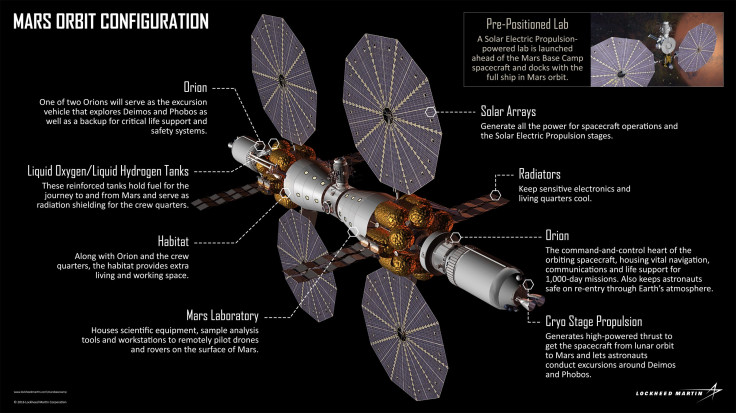Mission To Mars: Lockheed Martin Prepares For The Next Giant Leap; Unveils Design For Mars Base Camp

NASA plans to send humans to Mars sometime during the 2030s. However, before set foot on the surface of the red planet, we would probably have to orbit it — much like we did before landing on the moon.
“The concept is simple — transport astronauts from Earth to a Mars-orbiting science laboratory where they can perform real-time scientific exploration, analyze Martian rock and soil samples, and confirm the ideal place to land humans on the surface,” aerospace giant Lockheed Martin said in a statement released Wednesday, announcing its ambitious plan to place a “Mars Base Camp” in orbit around the red planet as early as 2028.
“The major components of the architecture will be launched separately. Some are pre-positioned in Mars orbit ahead of time. Others are assembled in cis-lunar space for the journey to Mars. Six astronauts will launch on Orion, which serves as the heart of the Mars Base Camp interplanetary ship,” the company added in the statement.

Cis-lunar space is the space between Earth and its moon. The company plans to assemble most of the structure during a series of missions in the region in the 2020s.
Although the technical details and the cost estimates of the project are yet to be announced, a concept design released during the Humans to Mars conference in Washington, D.C., Wednesday depicted a structure, built using two Orion crew capsules — which NASA and Lockheed are currently building — linked to a larger habitat and Mars laboratory module.
NASA plans to carry out the first uncrewed Orion test flight in 2018, followed by a crewed test-flight in 2021. Both of these would be powered by the powerful Space Launch System rocket.
The space agency is also working toward the creation of a reliable habitation system that can keep astronauts healthy and productive in the deep-space environment during missions that last up to 1,100 days.
“All of these pieces exist today, they're not brand new” Tony Antonelli, Lockheed Martin's chief technologist for civil space exploration, told Popular Science. “We're taking advantage of what we've already got. ... NASA has that in their plans, and we're coloring in the details.”
© Copyright IBTimes 2025. All rights reserved.






















